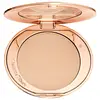What's inside
What's inside
 Key Ingredients
Key Ingredients

 Benefits
Benefits

 Concerns
Concerns

No concerns
 Ingredients Side-by-side
Ingredients Side-by-side

Talc
AbrasiveMica
Cosmetic ColorantPolymethyl Methacrylate
Dimethicone
EmollientSilica
AbrasivePentaerythrityl Tetraisostearate
EmollientCetearyl Ethylhexanoate
EmollientZinc Stearate
Cosmetic ColorantZea Mays Starch
AbsorbentChlorphenesin
AntimicrobialPotassium Sorbate
PreservativeTocopheryl Acetate
AntioxidantPei-10
Propylene Glycol
HumectantPrunus Amygdalus Dulcis Oil
Skin ConditioningRosa Multiflora Flower Wax
Skin ConditioningTetrasodium EDTA
Water
Skin ConditioningDimethiconol
EmollientTilia Cordata Flower Extract
Skin ConditioningMethylparaben
PreservativeEthylparaben
PreservativePropylparaben
PreservativeButylparaben
MaskingCI 77891
Cosmetic ColorantIron Oxides
Talc, Mica, Polymethyl Methacrylate, Dimethicone, Silica, Pentaerythrityl Tetraisostearate, Cetearyl Ethylhexanoate, Zinc Stearate, Zea Mays Starch, Chlorphenesin, Potassium Sorbate, Tocopheryl Acetate, Pei-10, Propylene Glycol, Prunus Amygdalus Dulcis Oil, Rosa Multiflora Flower Wax, Tetrasodium EDTA, Water, Dimethiconol, Tilia Cordata Flower Extract, Methylparaben, Ethylparaben, Propylparaben, Butylparaben, CI 77891, Iron Oxides
 Reviews
Reviews

Ingredients Explained
These ingredients are found in both products.
Ingredients higher up in an ingredient list are typically present in a larger amount.
Dimethicone is a type of synthetic silicone created from natural materials such as quartz.
What it does:
Dimethicone comes in different viscosities:
Depending on the viscosity, dimethicone has different properties.
Ingredients lists don't always show which type is used, so we recommend reaching out to the brand if you have questions about the viscosity.
This ingredient is unlikely to cause irritation because it does not get absorbed into skin. However, people with silicone allergies should be careful about using this ingredient.
Note: Dimethicone may contribute to pilling. This is because it is not oil or water soluble, so pilling may occur when layered with products. When mixed with heavy oils in a formula, the outcome is also quite greasy.
Learn more about DimethiconeTalc is a clay mineral. It helps absorb moisture and improve the texture of products. Like other types of clay, Talc can have a slight exfoliating effect on skin. Talc can be added to increase the volume of products.
Some Baby powders are made by combining talc with corn starch. The word "talc" comes from Latin and originates from Arabic. Talc is a mineral commonly found throughout the world.
If you have any concerns about using talc, we recommend checking out the FDA's official page.
Learn more about TalcTocopheryl Acetate is AKA Vitamin E. It is an antioxidant and protects your skin from free radicals. Free radicals damage the skin by breaking down collagen.
One study found using Tocopheryl Acetate with Vitamin C decreased the number of sunburned cells.
Tocopheryl Acetate is commonly found in both skincare and dietary supplements.
Learn more about Tocopheryl AcetateWater. It's the most common cosmetic ingredient of all. You'll usually see it at the top of ingredient lists, meaning that it makes up the largest part of the product.
So why is it so popular? Water most often acts as a solvent - this means that it helps dissolve other ingredients into the formulation.
You'll also recognize water as that liquid we all need to stay alive. If you see this, drink a glass of water. Stay hydrated!
Learn more about Water